Suppression of Mainlobe Jammers with Quadratic Element Pulse Coding in MIMO Radar
Abstract
:1. Introduction
2. Signal Model of QEPC-MIMO Radar
2.1. Quadratic Element Pulse Coding (QEPC) Scheme
2.2. Receive Signal Model
- denoted complex echo coefficient of the true target.
- was the resident phase of the true target after demodulating.
- was the transmit steering vector of the true targets.
- denoted demodulation vector.
- denoted the normalized Doppler shift frequency.
3. Mainlobe Deceptive Jammer Suppression in the QEPC-MIMO Scheme
3.1. Generation of Mainlobe Deceptive Jammers
- denoted complex echo coefficient of the -th FT.
- was the resident phase of the FT after demodulation.
- was the -th FTs’ transmit steering vector.
- represented the normalized Doppler frequency of the FT, which was assumed to be the same as true target.
- represented the normalized Doppler shift frequency of the FT.
3.2. Frequency Compensation and Distinguishment of the Targets
3.3. Mainlobe Deceptive Jammer Suppression
4. Jammers Suppression with DOA Mismatch
4.1. Model Formulation
4.2. Null Broadening Adaptive Beamforming Formulation
5. Simulations
5.1. Perfomance of Ideal Jammer Suppression
5.2. Performance of Robust Jammer Suppression
6. Discussion
7. Conclusions
Author Contributions
Funding
Data Availability Statement
Conflicts of Interest
References
- Wang, W.; So, H. Transmit Subaperturing for Range and Angle Estimation in Frequency Diverse Array Radar. IEEE Trans. Signal Process. 2014, 62, 2000–2011. [Google Scholar] [CrossRef]
- Neemat, S.; Krasnov, O.; Yarovoy, A. An interference mitigation technique for FMCW radar using beat-frequencies interpo-lation in the STFT domain. IEEE Trans. Microw. Theory Tech. 2019, 67, 1207–1220. [Google Scholar] [CrossRef] [Green Version]
- Cui, G.; Fu, Y.; Yu, X.; Li, J. Robust. Transmitter–Receiver Design in the Presence of Signal-Dependent Clutter. IEEE Trans. Aerosp. Electron. Syst. 2018, 54, 1871–1882. [Google Scholar] [CrossRef]
- Wang, W.; So, H.; Farina, A. FDA-MIMO Signal Processing for Mainlobe Jammer Suppression. In Proceedings of the 2019 27th European Signal Processing Conference (EUSIPCO), A Coruna, Spain, 2–6 September 2019; pp. 1–5. [Google Scholar] [CrossRef]
- Chu, Y.; Fang, W. Performance analysis of a wavelet-based generalized sidelobe canceller. IEEE Trans. Antennas Propag. 2003, 51, 519–534. [Google Scholar] [CrossRef]
- Keizer, W.P.M.N. Synthesis of Monopulse Antenna Patterns for Elliptical Phased Array Antennas With Different Peak Sidelobes Along the Principal Planes. IEEE Trans. Antennas Propag. 2019, 67, 5943–5950. [Google Scholar] [CrossRef]
- Al-Salehi, A.R.; Qureshi, I.M.; Malik, A.N.; Khan, Z.; Khan, W. Throughput Enhancement for Dual-Function Radar-Embedded Communications Using Two Generalized Sidelobe Cancellers. IEEE Access 2019, 7, 91390–91398. [Google Scholar] [CrossRef]
- Li, Z.; Ye, H.; Liu, Z.; Sun, Z.; An, H.; Wu, J.; Yang, J. Bistatic SAR Clutter-Ridge Matched STAP Method for Nonstationary Clutter Suppression. IEEE Trans. Geosci. Remote Sens. 2021, 60, 5216914. [Google Scholar] [CrossRef]
- Lin, Z.; Chen, Y.; Liu, X.; Jiang, R.; Shen, B. Adaptive Beamforming Design of Planar Arrays Based on Bayesian Compressive Sensing. IEEE Sensors J. 2021, 21, 5185–5194. [Google Scholar] [CrossRef]
- Al-Tous, H.; Barhumi, I.; Al-Dhahir, N. Narrow-Band Interference Mitigation Using Compressive Sensing for AF-OFDM Systems. IEEE Trans. Veh. Technol. 2017, 66, 6146–6159. [Google Scholar] [CrossRef]
- Tang, Z.; Deng, Y.; Zhang, H. High-fidelity SAR intermittent sampling deceptive jamming suppression using azimuth phase coding. IEEE Geosci. Remote Sens. Lett. 2021, 18, 489–493. [Google Scholar] [CrossRef]
- Yang, J.; Thompson, J.; Huang, X.; Jin, T.; Zhou, Z. Random-frequency SAR imaging based on compressed sensing. IEEE Trans. Geosci. Remote Sens. 2013, 51, 983–994. [Google Scholar] [CrossRef]
- Xu, G.; Zhang, B.; Yu, H.; Chen, J.; Xing, M.; Hong, W. Sparse Synthetic Aperture Radar Imaging from Compressed Sensing and Machine Learning: Theories, Applications and Trends. IEEE Geosci. Remote Sens. Mag. 2022, 10, 32–69. [Google Scholar] [CrossRef]
- Hoang, L.M.; Zhang, J.A.; Nguyen, D.N.; Huang, X.; Kekirigoda, A.; Hui, K.P. Suppression of Multiple Spatially Correlated Jammers. IEEE Trans. Veh. Technol. 2021, 70, 10489–10500. [Google Scholar] [CrossRef]
- Amin, M.; Zhan, L.; Lindsey, A. Subspace array processing for the suppression of FM jamming in GPS receivers. IEEE Trans. Aerosp. Electron. Syst. 2004, 40, 80–92. [Google Scholar] [CrossRef]
- Lan, L.; Xu, J.; Liao, G.; Zhu, S.; So, H.C. Mainlobe Deceptive Jammer Suppression in SF-RDA Radar: Joint Transmit-Receive Processing. IEEE Trans. Veh. Technol. 2022, 71, 12602–12616. [Google Scholar] [CrossRef]
- Ting., S.; Yong, G. TDOA estimation of dual-satellites interference localization based on blind separation. J. Syst. Eng. Electron. 2019, 30, 696–702. [Google Scholar] [CrossRef]
- Ge, M.; Cui, G.; Kong, L. Main lobe jamming suppression for distributed radar via joint blind source separation. IET Radar Sonar Navig. 2019, 13, 1189–1199. [Google Scholar] [CrossRef]
- Zhang, X.; Ma, H.; Wang, J.; Zhou, S.; Liu, H. Game Theory Design for Deceptive Jamming Suppression in Polarization MIMO Radar. IEEE Access 2019, 7, 114191–114202. [Google Scholar] [CrossRef]
- Yang, J.; Jin, T.; Huang, X.; Thompson, J.; Zhou, Z. Sparse MIMO array forward-looking GPR imaging based on compressed sensing in clutter environment. IEEE Trans. Geosci. Remote Sens. 2014, 52, 4480–4494. [Google Scholar] [CrossRef]
- Akhtar, J.; Olsen, K. Frequency Agility Radar with Overlapping Pulses and Sparse Reconstruction. In Proceedings of the 2018 IEEE Radar Conference (RadarConf18), Oklahoma City, OK, USA, 23–27 April 2018; pp. 0061–0066. [Google Scholar] [CrossRef]
- Yang, X.; Zhang, Z.; Zeng, T.; Long, T.; Sarkar, T.K. Mainlobe Interference Suppression Based on Eigen-Projection Processing and Covariance Matrix Reconstruction. IEEE Antennas Wirel. Propag. Lett. 2014, 13, 1369–1372. [Google Scholar] [CrossRef]
- Chang, S.; Deng, Y.; Zhang, Y.; Zhao, Q.; Wang, R.; Zhang, K. An Advanced Scheme for Range Ambiguity Suppression of Spaceborne SAR Based on Blind Source Separation. IEEE Trans. Geosci. Remote Sens. 2022, 60, 5230112. [Google Scholar] [CrossRef]
- Dai, H.; Wang, X.; Li, Y.; Liu, Y.; Xiao, S. Main-Lobe Jamming Suppression Method of using Spatial Polarization Characteristics of Antennas. IEEE Trans. Aerosp. Electron. Syst. 2012, 48, 2167–2179. [Google Scholar] [CrossRef]
- Sammartino, P.; Baker, C.; Griffiths, H. Frequency diverse MIMO techniques for radar. IEEE Trans. Aerosp. Electron. Syst. 2013, 49, 201–222. [Google Scholar] [CrossRef]
- Xu, J.; Liao, G.; Zhu, S.; Huang, L.; So, H.C. Joint Range and Angle Estimation Using MIMO Radar with Frequency Diverse Array. IEEE Trans. Signal Process. 2015, 63, 3396–3410. [Google Scholar] [CrossRef]
- Xu, J.; Zhu, S.; Liao, G. Range Ambiguous Clutter Suppression for Airborne FDA-STAP Radar. IEEE J. Sel. Top. Signal Process. 2015, 9, 1620–1631. [Google Scholar] [CrossRef]
- Wang, W.-Q.; So, H.C.; Farina, A. An Overview on Time/Frequency Modulated Array Processing. IEEE J. Sel. Top. Signal Process. 2017, 11, 228–246. [Google Scholar] [CrossRef]
- Wen, C.; Huang, Y.; Peng, J.; Wu, J.; Zheng, G.; Zhang, Y. Slow-time FDA-MIMO technique with application to STAP radar. IEEE Trans. Aerosp. Electron. Syst. 2022, 58, 74–95. [Google Scholar] [CrossRef]
- Lan, L.; Liao, G.; Xu, J.; Xu, Y.; So, H.C. Beampattern Synthesis Based on Novel Receive Delay Array for Mainlobe Interference Mitigation. IEEE Trans. Antennas Propag. 2023, 71, 4470–4485. [Google Scholar] [CrossRef]
- Gong, P.; Wang, W.-Q.; Li, F.; So, H.C. Sparsity-aware transmit beamspace design for FDA-MIMO radar. Signal Process. 2018, 144, 99–103. [Google Scholar] [CrossRef]
- Aubry, A.; De Maio, A.; Huang, Y. MIMO Radar Beampattern Design Via PSL/ISL Optimization. IEEE Trans. Signal Process. 2016, 64, 3955–3967. [Google Scholar] [CrossRef]
- Basit, A.; Wang, W.-Q.; Wali, S.; Nusenu, S.Y. Transmit beamspace design for FDA–MIMO radar with alternating direction method of multipliers. Signal Process. 2021, 180, 107832. [Google Scholar] [CrossRef]
- Basit, A.; Wang, W.-Q.; Nusenu, S.Y. Adaptive Transmit Array Sidelobe Control Using FDA-MIMO for Tracking in Joint Radar-Communications. Digit. Signal Process. 2020, 97, 102619. [Google Scholar] [CrossRef]
- Xu, J.; Liao, G.; Zhang, Y.; Ji, H.; Huang, L. An Adaptive Range-Angle-Doppler Processing Approach for FDA-MIMO Radar Using Three-Dimensional Localization. IEEE J. Sel. Top. Signal Process. 2016, 11, 309–320. [Google Scholar] [CrossRef]
- Lan, L.; Marino, A.; Aubry, A.; De Maio, A.; Liao, G.; Xu, J.; Zhang, Y. GLRT-Based Adaptive Target Detection in FDA-MIMO Radar. IEEE Trans. Aerosp. Electron. Syst. 2021, 57, 597–613. [Google Scholar] [CrossRef]
- Lan, L.; Xu, J.; Liao, G.; Zhang, Y.; Fioranelli, F.; So, H.C. Suppression of Mainbeam Deceptive Jammer With FDA-MIMO Radar. IEEE Trans. Veh. Technol. 2020, 69, 11584–11598. [Google Scholar] [CrossRef]
- Xu, J.; Liao, G.; Zhu, S.; So, H.C. Deceptive jamming suppression with frequency diverse MIMO radar. Signal Process. 2015, 113, 9–17. [Google Scholar] [CrossRef]
- Lan, L.; Liao, G.; Xu, J.; Zhang, Y.; Zhu, S. Mainlobe deceptive jammer suppression using element-pulse coding with MIMO radar. Signal Process. 2021, 182, 107955. [Google Scholar] [CrossRef]

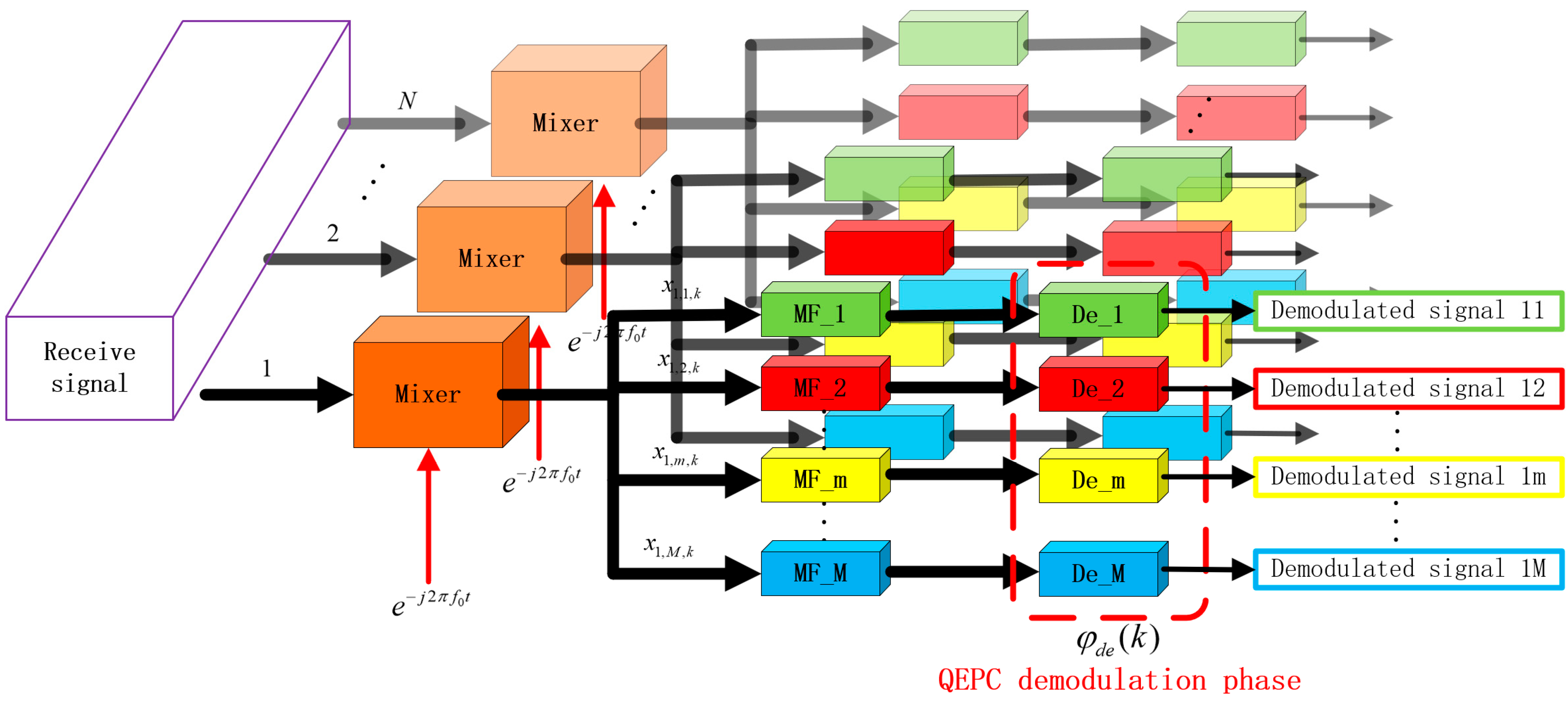
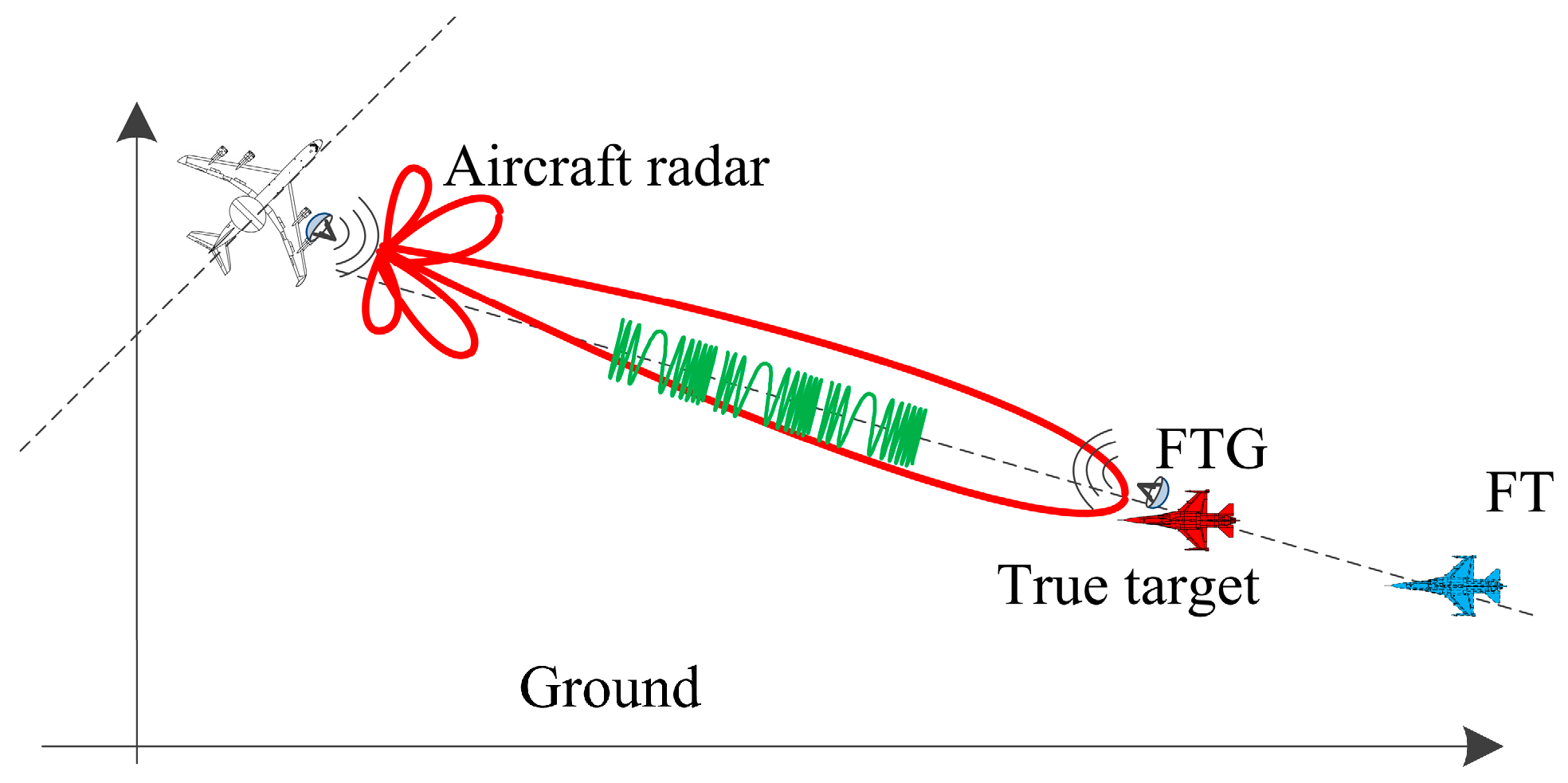
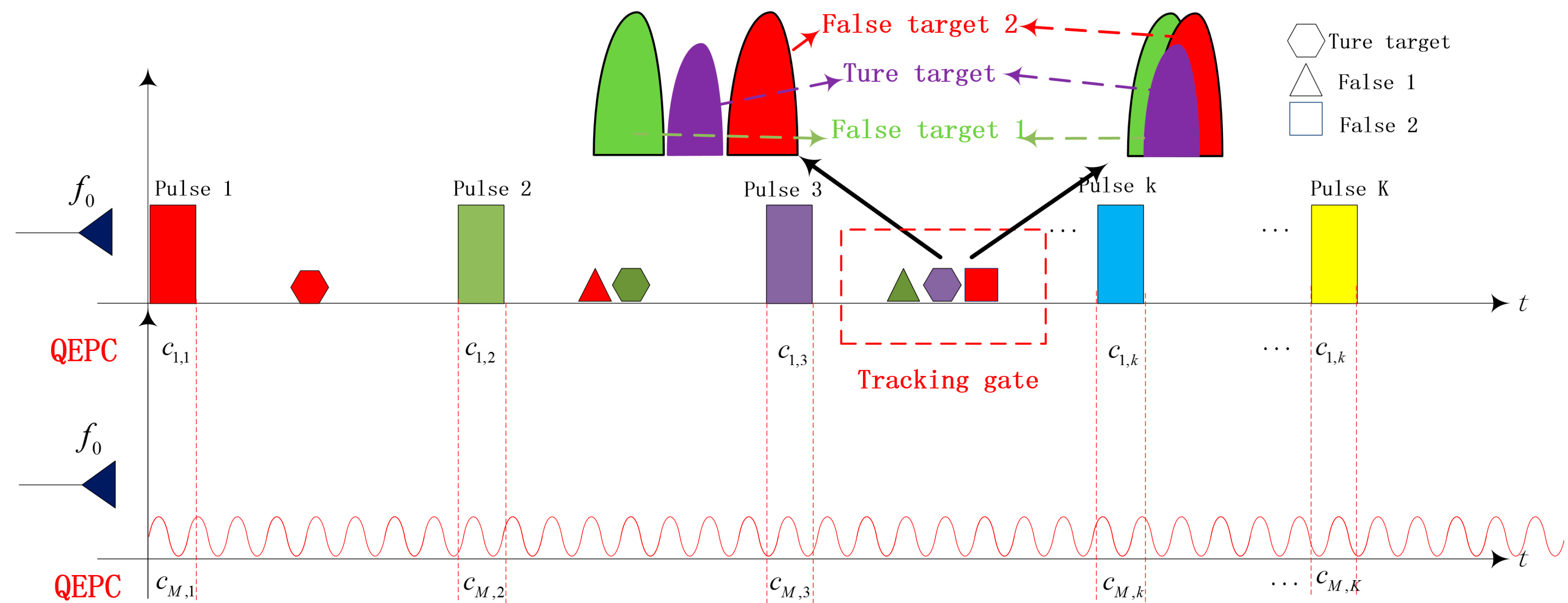
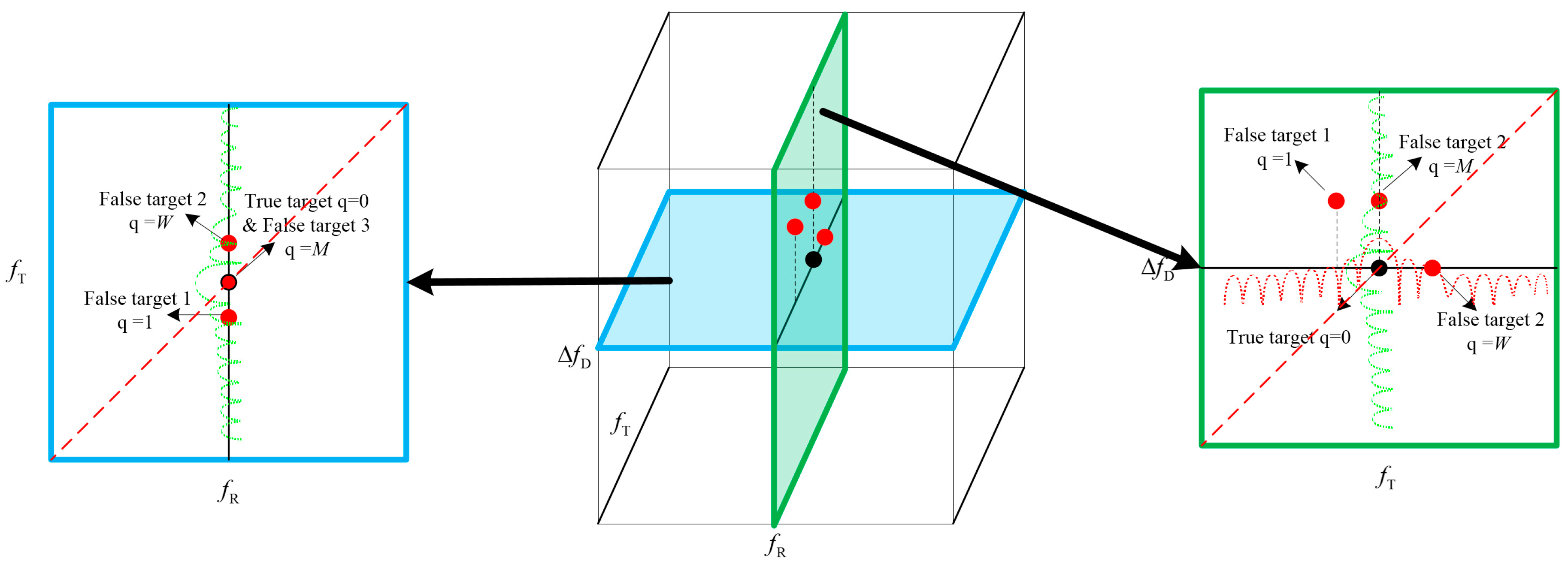
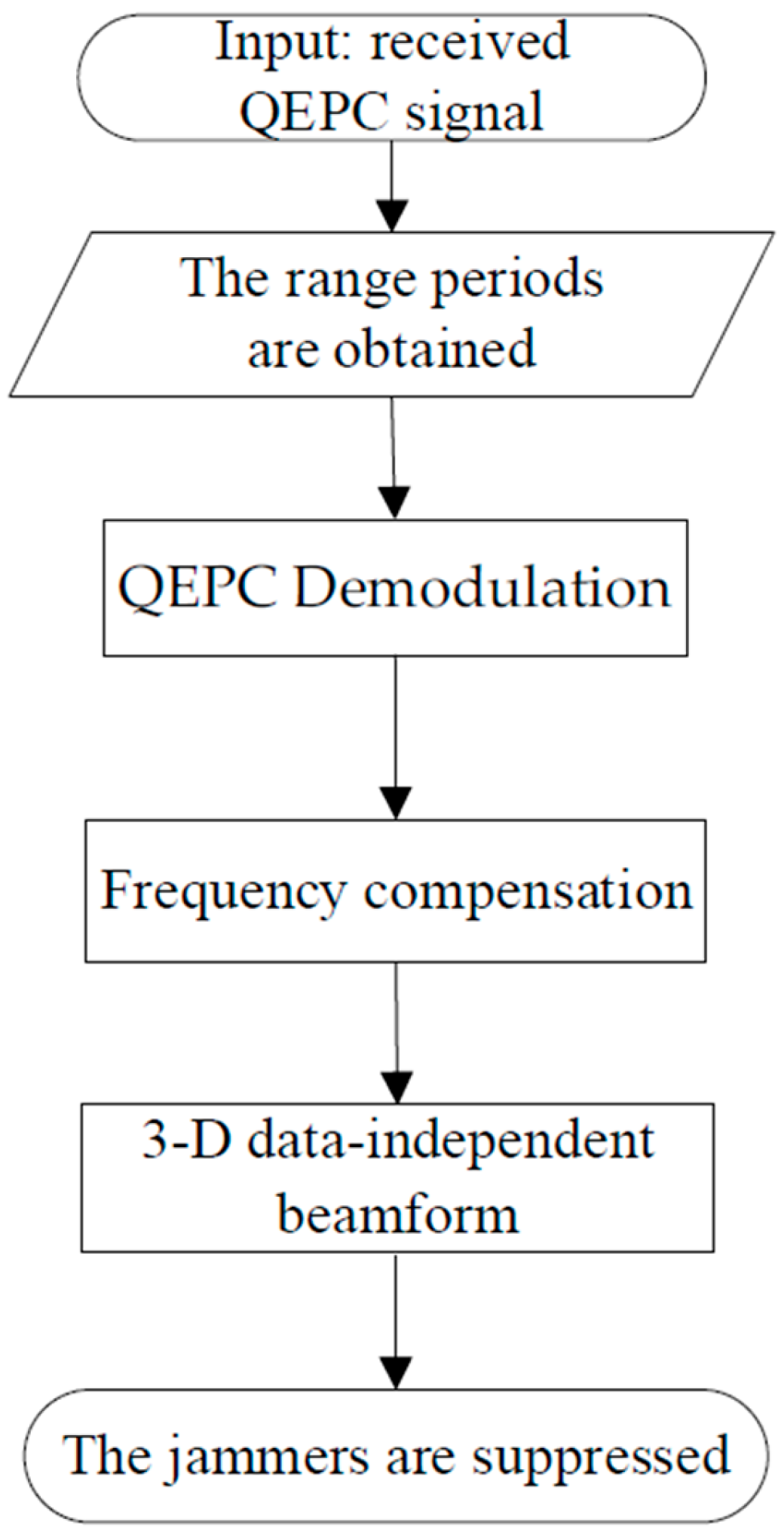
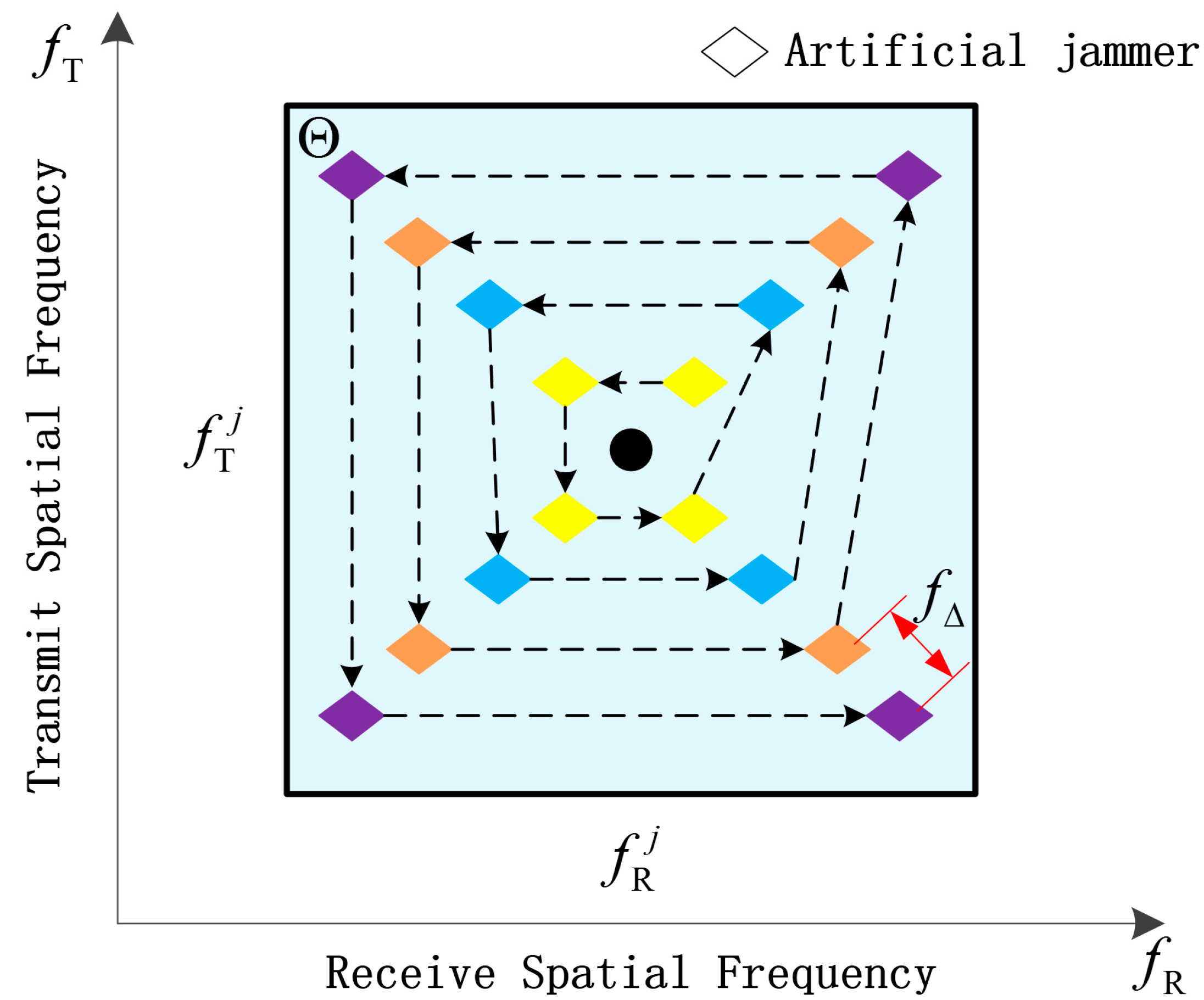
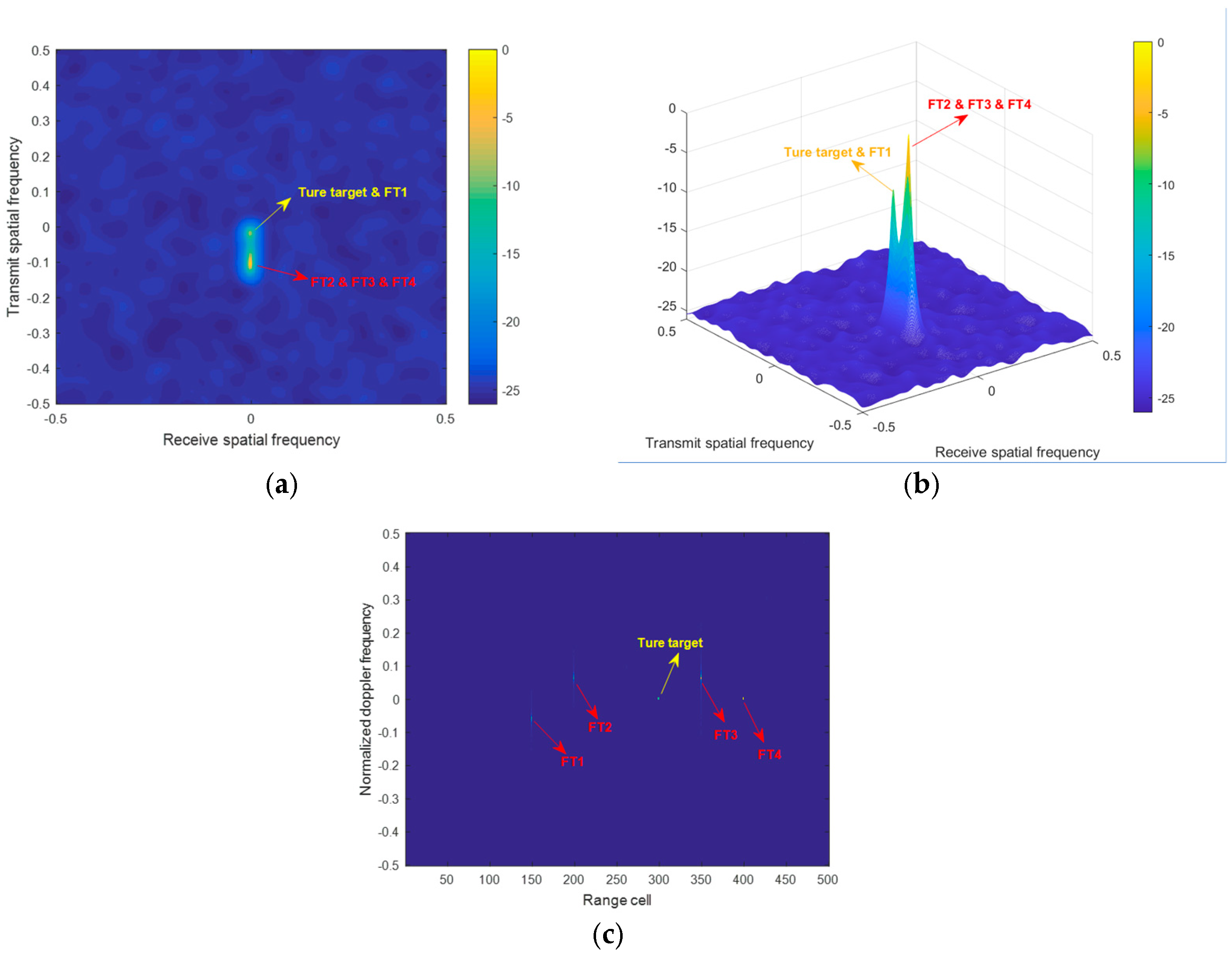
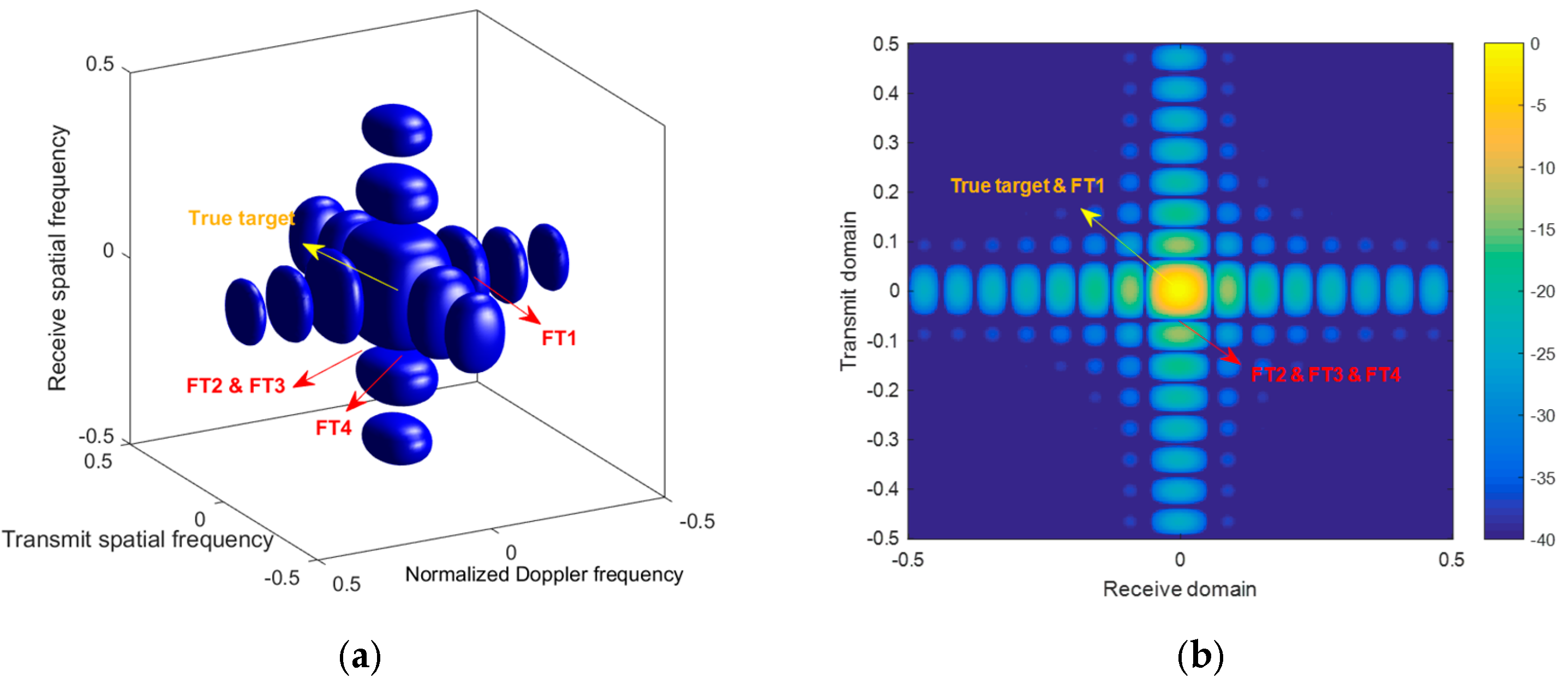
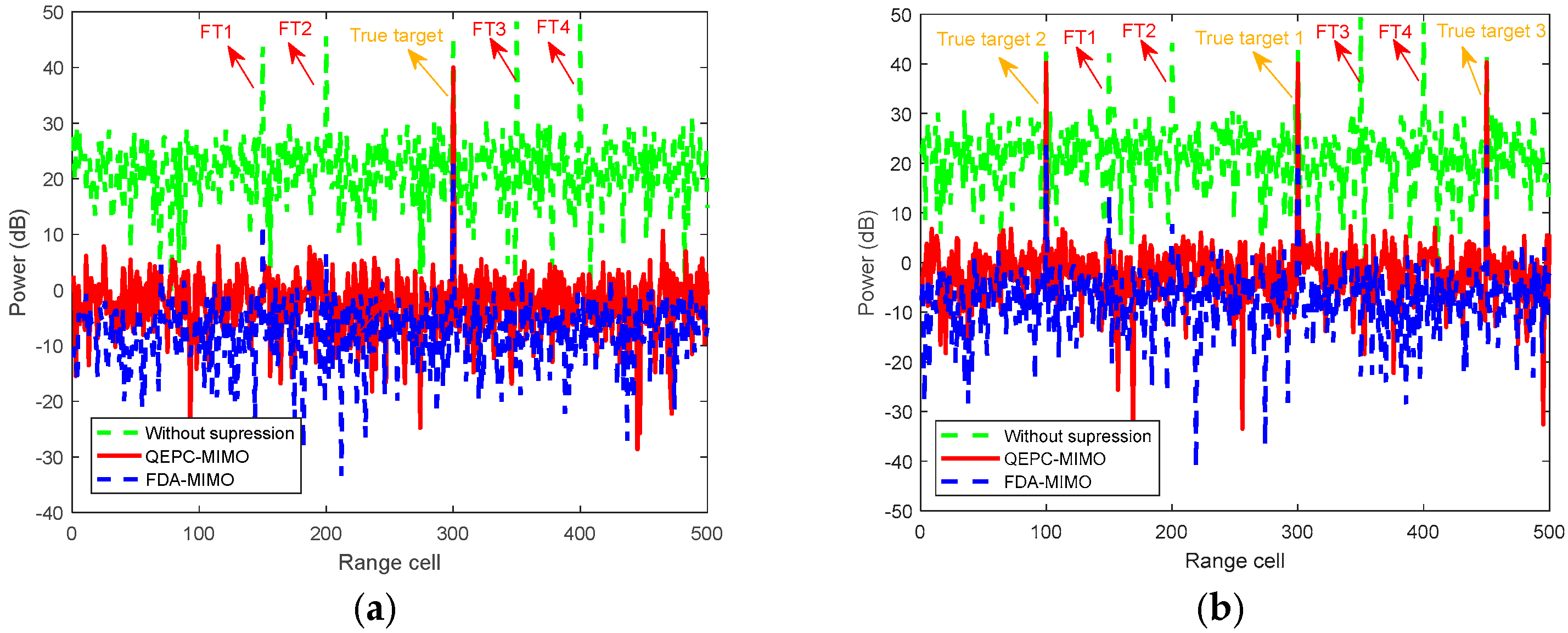
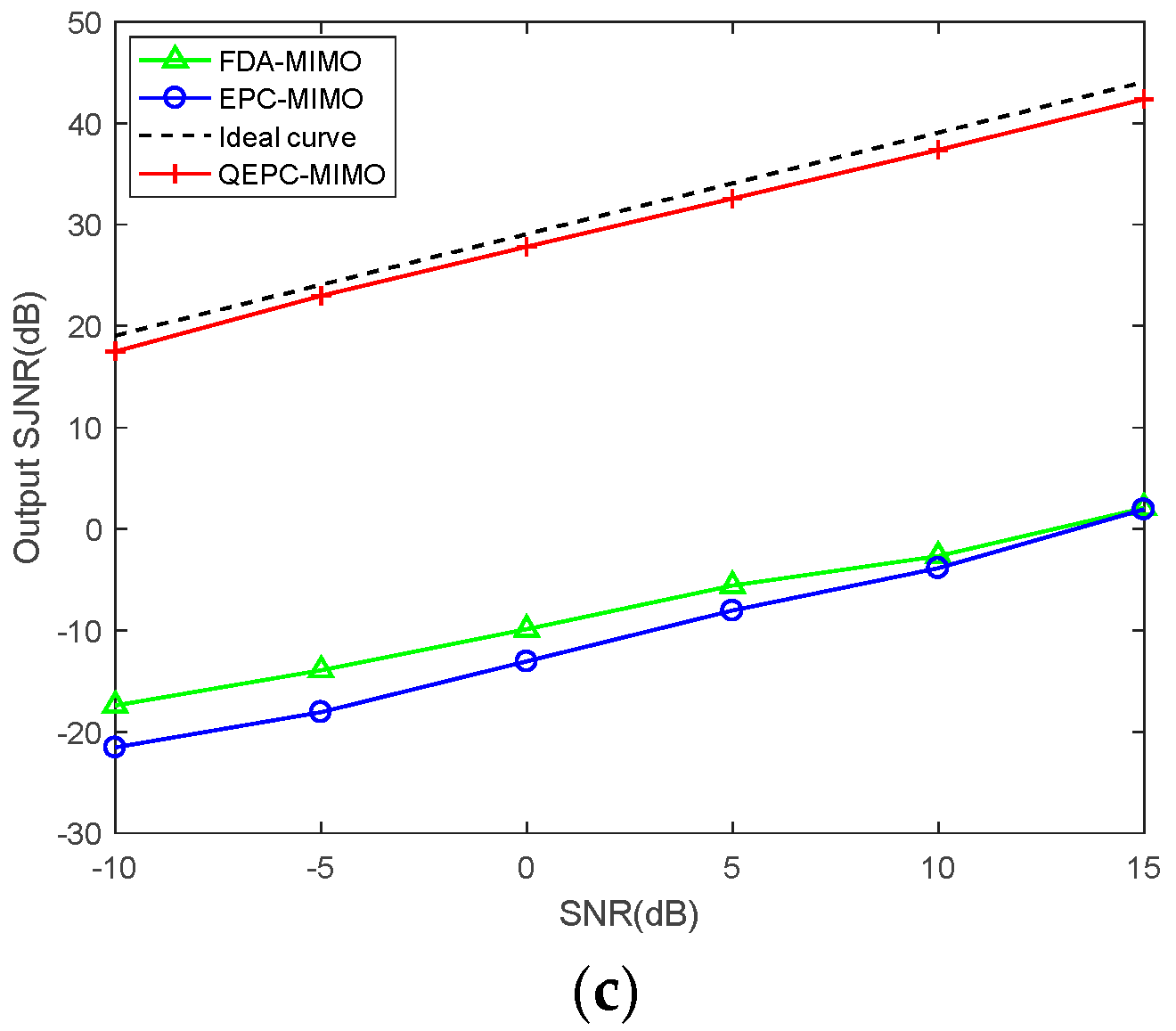
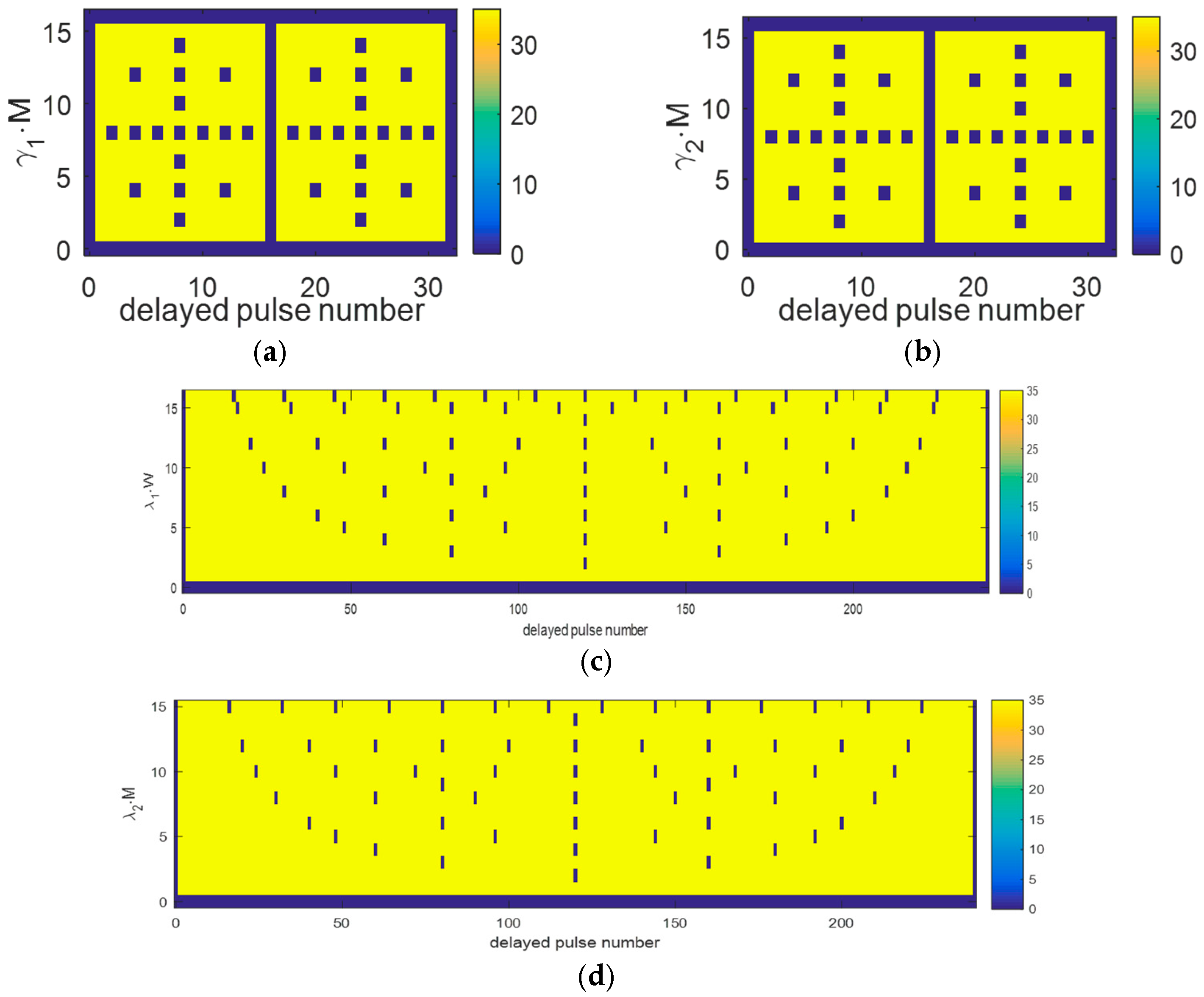
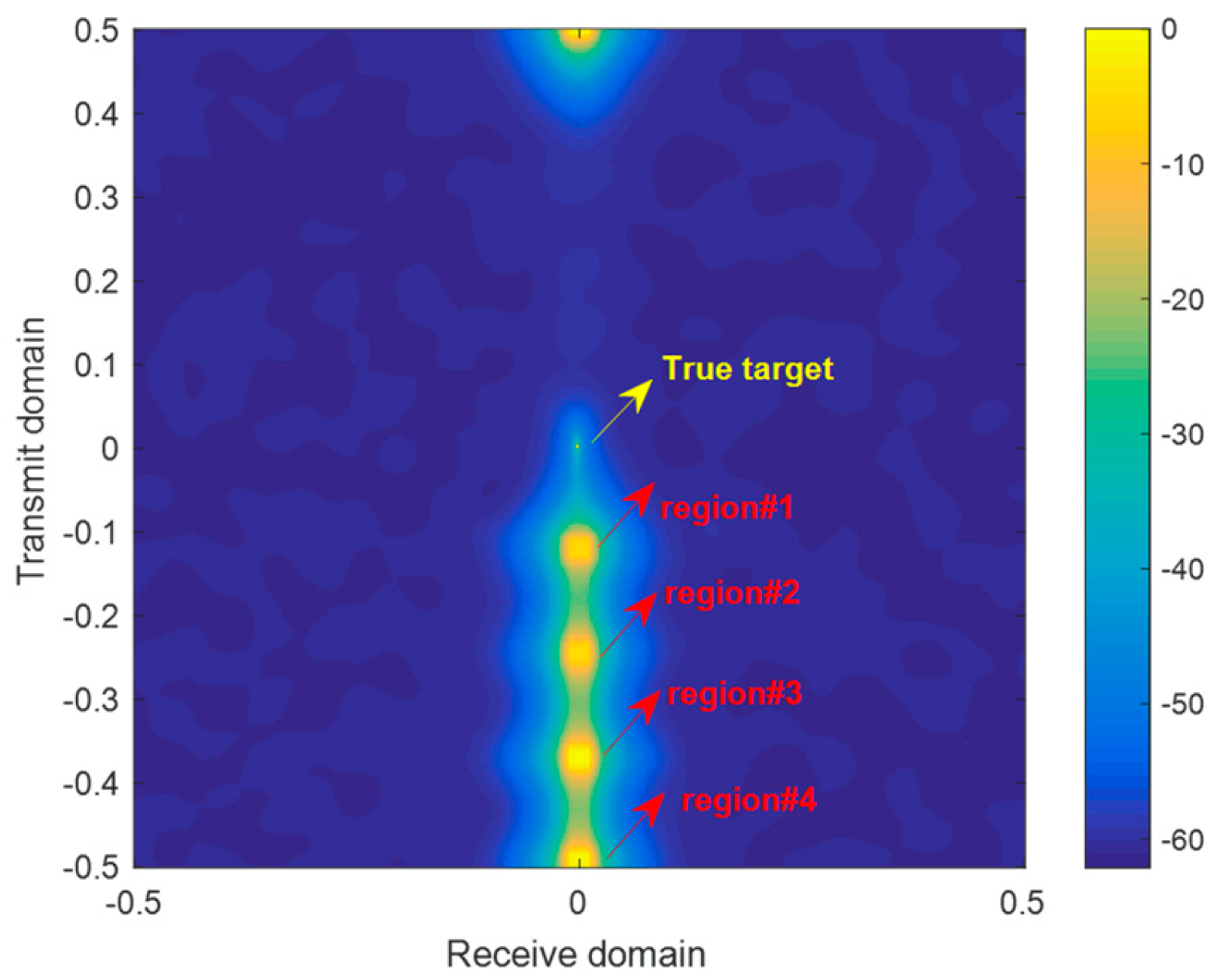
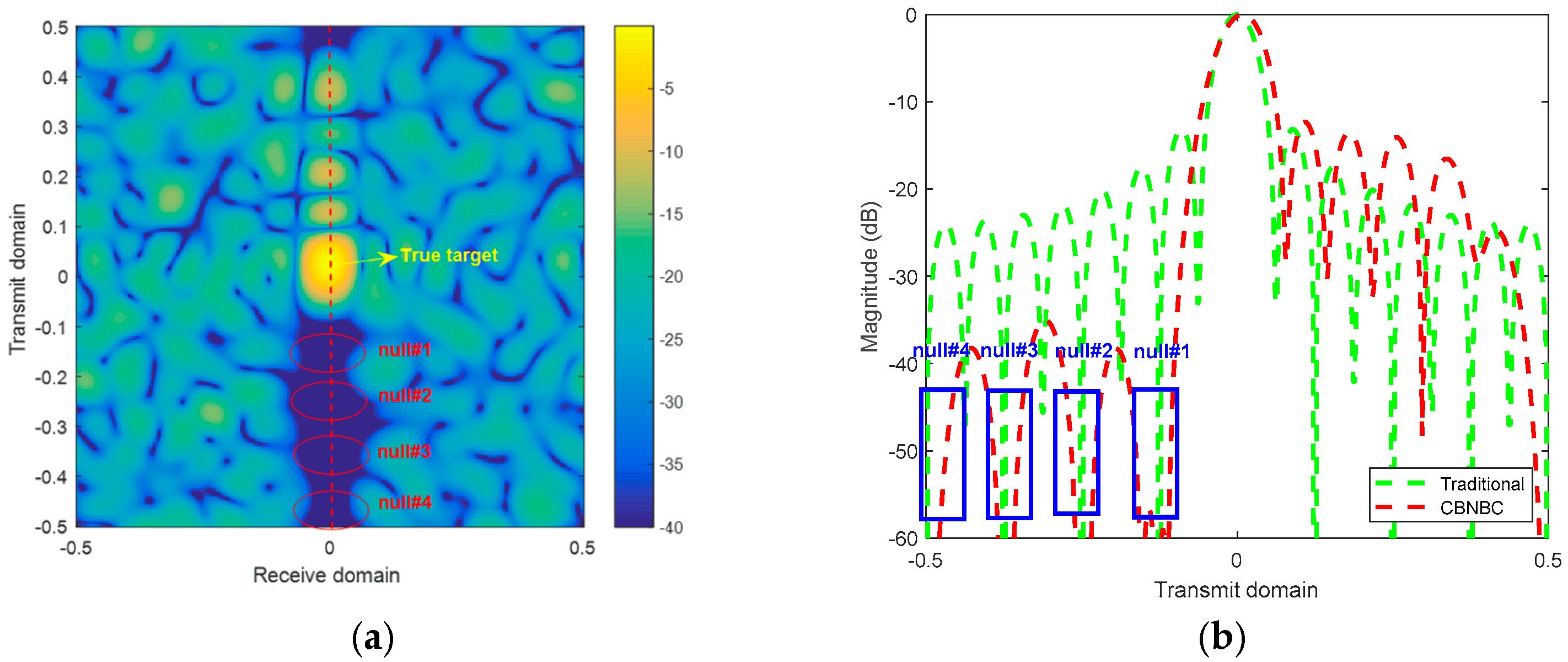
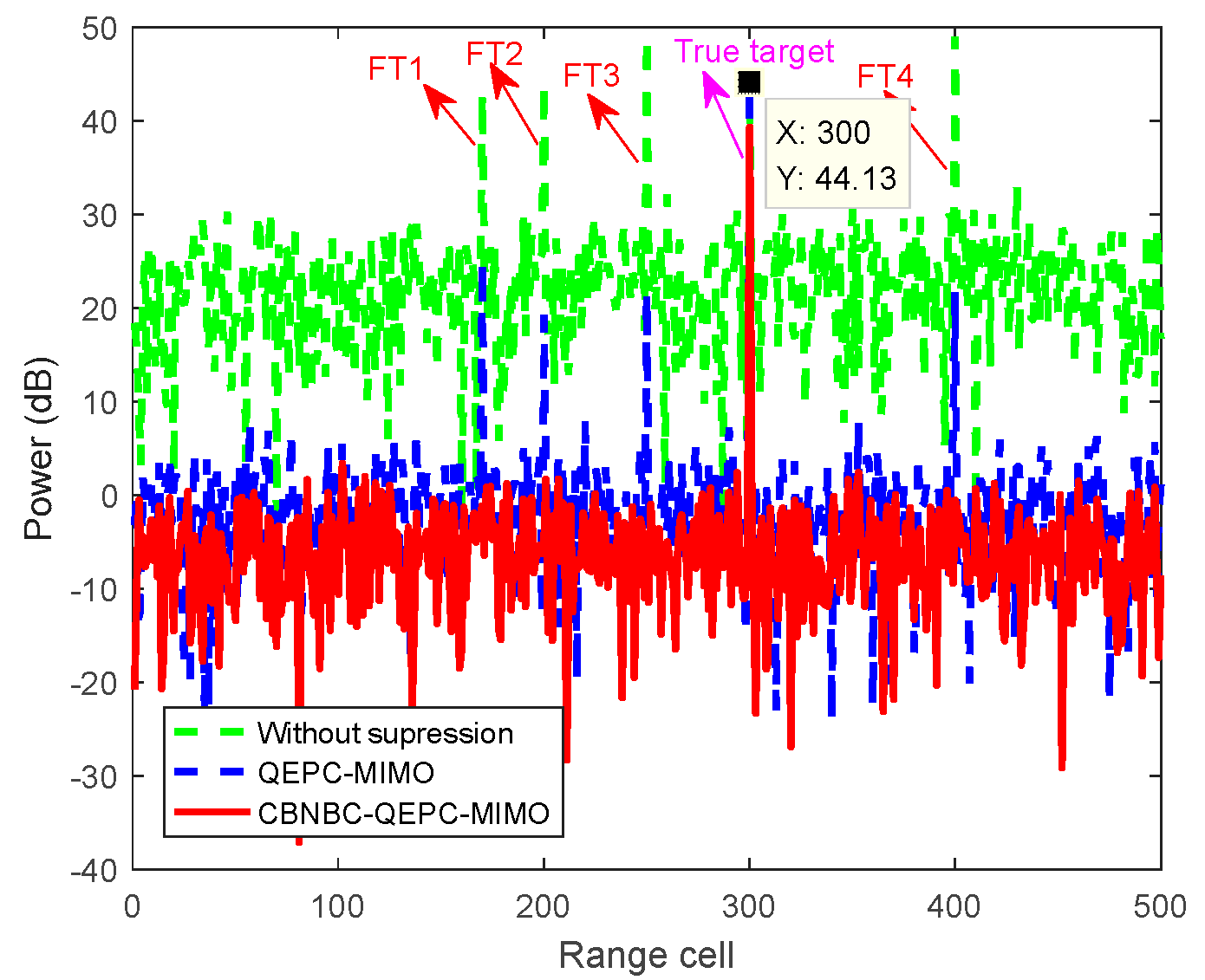
| Parameter | Value | Parameter | Value |
|---|---|---|---|
| Transmit elements space | 0.0093 m | Receive elements space | 0.0093 m |
| Transmit elements number | 15 | Receive elements number | 15 |
| The carrier frequency | 15 GHz | Pulse repetition frequency | 10 kHz |
| Coding coefficient | 1/15 | Coding coefficient | 1/16 |
| True Target | FT 1 | FT 2 | FT 3 | FT 4 | |
|---|---|---|---|---|---|
| Angle (°) | 0 | 0 | 0 | 0 | 0 |
| Range (km) | 9 | 4.5 | 6 | 10.5 | 12 |
| Range bin | 300 | 150 | 200 | 350 | 400 |
| Time delay (ms) | 0 | 1.47 | 0.08 | 0.11 | 1.62 |
| Velocity (m/s) | 20 | 20 | 20 | 20 | 20 |
| SNR (dB) | 20 | \ | \ | \ | \ |
| JNR (dB) | \ | 20 | 20 | 25 | 25 |
| Delayed pulse | 0 | 15 | 1 | 1 | 16 |
| True Target | FT 1 | FT 2 | FT 3 | FT 4 | |
|---|---|---|---|---|---|
| Angle error(°) | 1 | 1.5 | 2 | 2 | 1.5 |
| Angle (°) | 1 | −1.5 | 2 | −2 | 1.5 |
| Delayed pulse | 0 | 1 | 1 | 15 | 16 |
| Range(km) | 9.01 | 4.52 | 5.98 | 10.515 | 11.985 |
| Range bin | 300 | 170 | 200 | 255 | 400 |
| Time delay (ms) | 0 | 0.074066 | 0.079800 | 1.490033 | 1.619835 |
| SNR (dB) | 20 | \ | \ | \ | \ |
| JNR (dB) | \ | 20 | 20 | 25 | 25 |
Disclaimer/Publisher’s Note: The statements, opinions and data contained in all publications are solely those of the individual author(s) and contributor(s) and not of MDPI and/or the editor(s). MDPI and/or the editor(s) disclaim responsibility for any injury to people or property resulting from any ideas, methods, instructions or products referred to in the content. |
© 2023 by the authors. Licensee MDPI, Basel, Switzerland. This article is an open access article distributed under the terms and conditions of the Creative Commons Attribution (CC BY) license (https://creativecommons.org/licenses/by/4.0/).
Share and Cite
Zhang, Y.; Liao, G.; Lan, L.; Xu, J.; Zhang, X. Suppression of Mainlobe Jammers with Quadratic Element Pulse Coding in MIMO Radar. Remote Sens. 2023, 15, 3202. https://doi.org/10.3390/rs15123202
Zhang Y, Liao G, Lan L, Xu J, Zhang X. Suppression of Mainlobe Jammers with Quadratic Element Pulse Coding in MIMO Radar. Remote Sensing. 2023; 15(12):3202. https://doi.org/10.3390/rs15123202
Chicago/Turabian StyleZhang, Yiqun, Guisheng Liao, Lan Lan, Jingwei Xu, and Xuepan Zhang. 2023. "Suppression of Mainlobe Jammers with Quadratic Element Pulse Coding in MIMO Radar" Remote Sensing 15, no. 12: 3202. https://doi.org/10.3390/rs15123202







